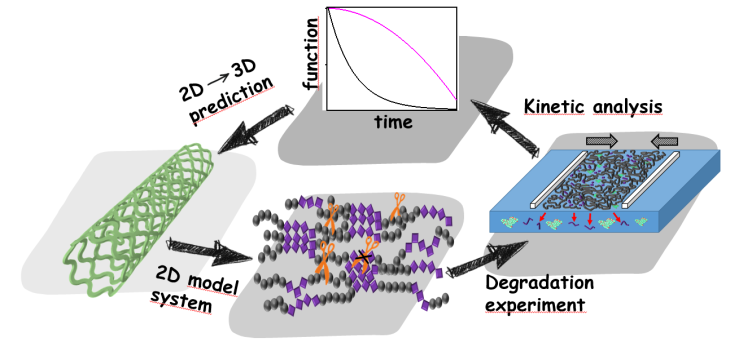Jan 24 2020
In the current medical field, polymer materials have a crucial role to play. Although several applications necessitate highly durable devices, others benefit from materials that degrade as soon as they are used once. Designing such materials mostly relies on the ability to predict their degradation behavior.
 The materials allowing the implementation of multiple functions such as drug release or shape-changing capabilities into degradable polymer devices have sophisticated molecular architectures. Studying their degradation behavior in monolayers at the air-water interface allows for rapid and straightforward assessment of the evolution of the material properties. The insights gained by this predictive tool point at design principles for the next generation of multifunctional devices. Image Credit: Helmholtz-Zentrum Geesthacht.
The materials allowing the implementation of multiple functions such as drug release or shape-changing capabilities into degradable polymer devices have sophisticated molecular architectures. Studying their degradation behavior in monolayers at the air-water interface allows for rapid and straightforward assessment of the evolution of the material properties. The insights gained by this predictive tool point at design principles for the next generation of multifunctional devices. Image Credit: Helmholtz-Zentrum Geesthacht.
Headed by Prof. Andreas Lendlein, a research team from the Helmholtz-Zentrum Geesthacht has now developed a technique for more reliable and faster prediction of the degradation of these polymer materials using advanced molecular architectures. The study outcomes were recently published in the first issue of the Cell Reports Physical Science journal.
The researchers used the so-called Langmuir technique to transfer the material into a 2D system, thus eliminating the complex transport processes that have an impact on the disintegration of three-dimensional objects.
Analytical models that describe various polymer architectures that are of specific interest in designing multifunctional implants were created, and the kinetic parameters elucidating the disintegration of these materials were determined.
Furthermore, the team intends to apply these data to perform computer simulations of the degradation of therapeutic polymer devices. Already, regulatory authorities have recommended computer simulations of the performance of these devices, for instance, for certain stents.
The knowledge obtained from the 2D degradation studies will certainly enhance these simulations. The HZG researchers have devised a technique for quickly perceiving and predicting the decomposition of polymer materials, thereby considerably contributing toward developing novel, multifunctional polymers for regenerative medicine.
Background—Multifunctional Biomaterials
It could be useful to implement degradability for specific implants, like staples or sutures. These implants are required only temporarily as mechanical support. It is expected that future medical implants will carry out much more complex tasks.
For instance, these degradable devices could be compressed, making them implantable through minimally invasive techniques, where they release a drug for supporting the healing process, recruit the correct cells to its surface, and send reports back on the recovery progress.
In this case, disintegration is just one out of various functions combined in the materials. However, degradation is largely crucial since it alters the material on a molecular level. A material’s molecular structure is developed in a unique, typically complex, way to implement various functions into it.
It is crucial to gain insights into ways degradation has an impact on this molecular architecture to make sure that all the functions are performed in the desired manner. The thin layer technique that this study developed could have a groundbreaking role in developing such degradable polymers.